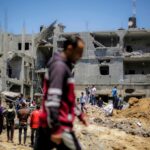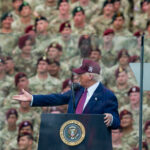Earlier this month, an armed group launched an overnight attack on a village in northern Burkina Faso, killing at least 160 civilians, burning homes, and destroying a local market. This atrocity is part of a larger escalation of violence and displacement in the Sahel — a region of west and north-central Africa including Burkina Faso, Niger, Mauritania, Chad, and Mali — where the United States has a long history of troubled military intervention.
Following September 11, 2001, the Sahel became yet another frontier for the US “War on Terror.” The United States ramped up “security assistance” to countries in the region, including training and equipping their militaries, as well as expanding surveillance programs and secretive counterterrorism missions. Two decades later, armed conflict is exploding in the Sahel, making clear that this militarized US strategy has not prevented violence. Instead, it has enabled governments and security forces in the Sahel to commit abuses while waging their own post-9/11 wars.
Ending our endless wars — as President Biden has pledged to do — cannot just mean bringing US combat troops home. It must mean ending the other policies that continue to perpetuate violence and fuel mass atrocities around the world — in this case: the $1.44 billion in “security assistance” we have provided to abusive foreign militaries in the Sahel. If the Biden administration won’t seek this change on its own, Congress has immediate opportunities to set a new agenda for the Sahel and reorient the US approach to conflict more broadly.
WHAT IS THE US EVEN DOING IN THE SAHEL?
In reaction to 9/11, the United States drastically increased its military footprint all over the globe. Over time, the US government secretly expanded its military and intelligence presence in the Sahel via “by, with, and through” operations and “train and equip” programs. These provide training, assistance, weapons, and equipment to local militaries and police, with very little transparency or measurable outcomes. At times, it appears that even senior members of Congress were not aware the US military was involved in a given country until a US service member died there.
In 2005, the United States created an interagency program, the Trans-Sahara Counterterrorism Partnership, to implement a comprehensive strategy for the region. However, the program has been largely unsuccessful at coordinating across agencies to address the multifaceted causes of violence in the Sahel. The predominance of the militarized counterterrorism mindset overshadowed this goal in favor of focusing on military-to-military relations.
Today, the United States continues to provide “security assistance” through these programs, despite clear signs that this militarized strategy is utterly failing to keep people safe.
Since 2015, violence has been sharply rising in the Sahel, increasing 44% from 2019 to 2020 alone. The Sahel is a poor region, grappling with the impacts of French colonialism and ongoing international military intervention. Climate change is increasingly ruining crops and livelihoods, leading to resource scarcity, unemployment, corruption, and exploitation. These factors combined, more than 2.7 million people have been forced to flee their homes.
HOW US “SECURITY ASSISTANCE” FUELS VIOLENCE
Not only is the US approach to the Sahel failing to prevent violence, in many cases it is actually entrenching violent groups and harming local people. Corrupt elites in the Sahel are often incentivized to profit from US military resources, using various tactics like fictitious “ghost soldiers” to siphon off state funds. Further, US military training has been found to nearly double the likelihood that a country will experience a military coup to overthrow the government. In Mali, there have been three coups in the past decade, all led by US-trained military officials.
Not only is the US approach to the Sahel failing to prevent violence, in many cases it is actually entrenching violent groups and harming local people.
There are also frequent reports of human rights abuses by the security forces that we train and equip. Within just three months in 2020, soldiers in Niger, Burkina Faso, and Mali — all US security partners — murdered or abducted at least 199 people. The United States rarely holds partner governments accountable or discontinues military aid after human rights abuses occur, in part because many counterterrorism operations are so opaque.
In fact, our obsessive focus on “counterterrorism” has enabled governments to weaponize this narrative and the accompanying US resources against their own people. In Burkina Faso, for example, the government has sought to persecute the Fulani, an ethnic minority group, by claiming they are terrorists. In some cases, the threat of violence from the state causes some civilians to turn to armed groups for protection. One study found that 75% of villages surveyed in Mali and Burkina Faso thought that their government’s security forces threatened their communities’ peace and security, and a full 50% said that violent extremist groups helped protect them.
But in spite of this evidence that the US strategy is detrimental, the Biden administration has so far doubled down on “security assistance” as its core approach to countering violence in the Sahel.
DOING THE SAME THING AND EXPECTING DIFFERENT RESULTS
The Pentagon has admitted that its counterterrorism missions in the Sahel are largely failing. US “train and equip” has had little transformative effect. Multiple reports by the Government Accountability Office have found that the Trans-Sahara Counterterrorism Partnership isn’t effective because it’s uncoordinated and overly militarized. Yet all signs point to continuing business as usual.
Why?
First of all, failure isn’t fun. According to interviews with former government officials, there’s a persistent unwillingness to admit defeat or acknowledge that US policies may be fueling violence. Nobody wants to bring bad news to the president, and so bureau and embassy staff often feel pressure to show that our current strategy is working. In turn, when violent attacks break out, the US government is put in crisis response mode, trying to avert conflict after it occurs.
Crisis response mode is heightened by (justified) public pressure to “do something” about a growing conflict. Typically, “doing something” means turning to the military tools at our disposal. This response is also driven by the military-industrial complex. Yes — a big, fancy, annoying buzzword. But truly, the financial interests of weapons companies and lobbyists keep us leaping at the opportunity to train, equip, and sell arms and surveillance tools to governments and militaries around the world.
The impetus for the current “security assistance” approach is, of course, also rooted in a desire to protect ourselves. But evidence shows that militarized responses to our own feelings of insecurity lead to policies that terrorize other people, which only feed cycles of conflict. Creating security for ourselves actually depends on building our collective human security. And that necessitates a drastic shift in the way we approach violence and armed conflict.
A PROVEN WAY TO MITIGATE VIOLENCE
Luckily, it’s not too late for Congress to push the Biden administration to change course in the Sahel. To start, Congress should hold partner governments and militaries accountable for human rights abuses. The Foreign Affairs committees could invoke a human rights review of countries in the Sahel and set up congressional action on security assistance reform. Congress can also require human rights pre-vetting and anti-corruption provisions for our unaccountable “train and equip” partnerships.
More broadly, Congress has a chance to kick the idea that more military, more training, and more weapons leads to peace. Instead of continuing to throw money at a decades-old strategy that has clearly failed, Congress can use the appropriations and authorization processes to defund militarized “security assistance.” It can then shift this funding to peacebuilding and prevention programs that facilitate long-term local capacity building. Crucially, Congress should measure the effectiveness of these programs by whether they fulfill the needs of local communities and are in line with the demands of civil society networks in the Sahel who are already demanding change in their own right.
To pivot to a conflict prevention strategy instead of crisis response, Congress doesn’t have to start from scratch. As Win Without War’s Herbert Scoville Jr. Peace Fellow, Caroline Smith, showed in her recent report, the US. government already has many of the tools to predict and prevent mass violence, which have been proven to work when used in conjunction with a mobilized and robust local civil society.
The escalating crisis in the Sahel presents a critical opportunity to “do something” more than another failed military intervention. It’s a chance to admit that training foreign militaries and exporting militarism doesn’t make people safer. While action on the Sahel is urgent, the region is only a microcosm of what armed conflict will look like this century, especially as the impacts of climate change continue to grow. With an increasing interest in Washington in a more proactive US policy towards Africa, a new strategy for the Sahel could serve as a model to reform the US approach to violence more broadly.
Amisha Parikh-Friese is the Policy Associate at Win Without War. She has a background in grassroots human rights advocacy, congressional reform, and peacebuilding.














